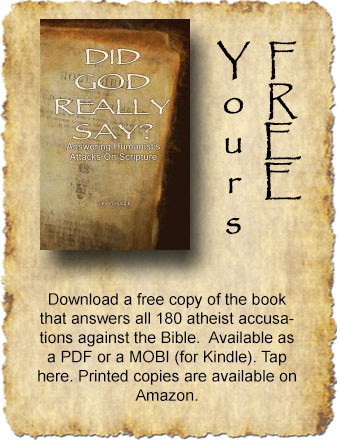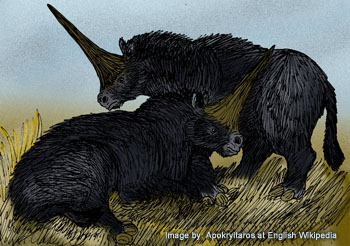Atheist's Attacks
Answering Humanist's Accusations Against the Bible


Does Science Prove the Bible Wrong? Nope!
Are there dragons and unicorns in the Bible?
THE HUMANIST'S CLAIM there are: Additional Errors About the Physical World
The Bible has verses mentioning dragons (Jeremiah 51:34), unicorns (Isaiah 34:7), and cockatrices (Isaiah 11:8). These passages led many naturalists in the Middle Ages to think such mythical creatures actually exist.[White, Vol. I, pp. 33-35]
As best I can find, the humanist seems to be referring to the following claim by Andrew White:

Thus was developed a sacred science of creation... Like all else in the Middle Ages, this sacred science was developed purely by theological methods. Neglecting the wonders which the dissection of the commonest animals would have afforded them, these naturalists attempted to throw light into Nature by ingenious use of scriptural texts, by research among the lives of the saints, and by the plentiful application of metaphysics. Hence even such strong men as St. Isidore of Seville treasured up accounts of the unicorn and dragons mentioned in the Scriptures. - Andrew White, History of the Warfare of Science with Theology in Christendom, from chapter 2 (Kindle location 1108 & 1115)
Then on pages 34 & 35, attempting to discredit Christian sources, White quotes a 13th century English friar, Bartholomew Anglicus. He is famous for creating the first encyclopedia. It was translated into numerous languages and was used as an authoritative reference for several hundred years. Here is the quote:
“Naturally this good Franciscan naturalist devotes much thought to ‘dragons’ mentioned in scripture. He says, ‘The dragon is the greatest of all serpents, and oft he is drawn out of his den and riseth up into the air, and the air is moved by him, and also the sea swelleth against his venom, and he hath a crest and reareth his tongue, and hath teeth like a saw, and hath strength and not only in teeth but in tail, and grieveth with biting and with stinging. Whom he findeth he slayeth. Oft four or five of them fasten their tails together and rear up their heads and sail over the sea to get good meat. Between elephants and dragon is everlasting fighting, for the dragon with his tail spanneth the elephant, and the elephant with his nose throweth down the dragon… The cause why the dragon desireth his blood is the coldness thereof, by which the dragon desireth to cool himself. Jerome saith that the dragon is full thirsty beast, insomuch that he openeth his mouth against the wind to quench the burning of his thirst in that wise. Therefore, when he seeth ships in the great wind he flieth against the said to take the cold wind, and overthroweth the ship.”
In this case White does identify his source, however, what is White claiming? That Bartholomew, in documenting the knowledge of his day (the year 1230), described a living creature he called a dragon? Is that a problem?
White, writing 650 years after Bartholomew, assumes this description of a dragon is based on theology, not observation. Giving no evidence, he claims that naturalists of the 13th century used non-observational methods and twisted reality to conform it to scripture. What is the basis of this conclusion? White offers no explanation.
The fact is those involved in science in the 13th century, such as Bartholomew, were most often monks. The secular world had abandoned science and the search for knowledge. It was Christianity that both preserved scientific knowledge, and continued to advance science throughout the Middle Ages. That means, of course, the scientific writings we have from that time are by Christians… and that is not the story White wants known.
My conclusion is that White assumes dragons are mythological creatures, and because Bartholomew describes them as real, living animals, then Bartholomew must have abandoned observational science in favor of Christian mythology. However, what if dragons are real? What if we no longer call them dragons? Batholomew may have enhanced his description somewhat, but it does not make sense for him to put a mythical animal in a factual encyclopedia. He was describing a real animal.
The KJV Bible talks about dragons, unicorns, and cockatrices. I particularly like dragons, and I even own some real fossil "dragon" footprints. The word "dragon" (or the plural: dragons) is used 35 times in the KJV Bible. Do you know what scripture is talking about when it uses the word "dragon?
Dragons Were Real, Living Animals
By making the statement quoted at the beginning of this chapter the humanists must now feel they have won their argument. The Bible is filled with error (dragons), and those who defend it (such as myself) believe in myths and fairy tales. Only crazy Christians, who deny the reality of science, believe such nonsense as dragons. So… why am I saying dragons are real?
In some cases, such as in Revelation, the word “dragon:” is referring to that “dragon” Satan. In that instance, it is figurative language describing the power and destructive nature of Satan. When used this way the Greek word translated as "dragon" is Strong's 1404, “drakon.” It means a large serpent with a keen sense of sight.
Outside of Revelation, the word "dragon" is only found in the Old Testament and it translates the Hebrew word "tannin," Strong's 8577. The Bible describes real, living creatures more realistically than Bartholomew. For example:
And the wild asses did stand in the high places, they snuffed up the wind like dragons; their eyes did fail, because there was no grass. - Jeremiah 14:6 KJV
Thou shalt tread upon the lion and adder: the young lion and the dragon shalt thou trample under feet. - Psalm 91:13 KJV
Current English translations, influenced by evolution, use the words “jackal and “serpent” instead of dragon. However, those words are not accurate. The literal definition of "tannin" is "a land or sea monster. This is not a King Kong or Godzilla type of monster. The meaning is that of a "monster" in the sense of being strong and vicious. A jackal somewhat fits within the Hebrew definition of "monster." However, scripture is not talking about jackals.
The KJV use of the word “dragon” is more accurate than jackal or serpent used in other translations. What type of animal is a "dragon?" There is a certain animal, created by God on day six of creation that was not given its current name until 1841. The KJV was originally translated in 1611, with the last update in 1769, well before the current name for this animal came into use.
I assume some of you are thinking, “The last of the dinosaurs died 65 million years ago. It's impossible, people and dinosaurs didn't live together." Well... the basis of that "fact" is propaganda and indoctrination . If you look at the actual scientific evidence, it strongly shows that dinosaurs lived with people until recently... very recently.
I made a video on this topic: Men and Dinosaurs. It's available on YouTube (www.tinyurl.com/y8o9m3e7). I made this video in 2010. Since then A LOT of new evidence has become available, such as red blood cells and soft tissue found in numerous dinosaur bones. Neither of these could survive for millions of years. Even based just on secular science, the evidence is overwhelming that dinosaurs and people lived together recently. See our web sites: www.DinosaursForJesus.com and www.DinosaurTracker.com
For in-depth Biblical and scientific evidence demonstrating that people and dinosaurs lived together, I recommend the following two web sites. There are many other good web sites, but both of these are comprehensive and both provide of of good information:
www.Creation.com (see the multimedia section for online videos)
www.AnswersInGenesis.com
What About Unicorns?
His glory is like the firstling of his bullock, and his horns are like the horns of unicorns [wild ox]: with them he shall push the people together to the ends of the earth: - Deuteronomy 33:17
But my horn shalt thou exalt like the horn of an unicorn [wild ox]: I shall be anointed with fresh oil. - Psalm 92:10

In these two verses, we see the NASB and ESV replace the word "unicorn" with "wild ox." The Hebrew word used here is "rame," Strong's 7214. Strong's gives the definition as “wild bull, from conspicuousness.” Rame is referring to a bull-like animal that is strong. That certainly does not sound like how we picture a “unicorn” today.
Is a unicorn a real animal? Yes. In Job 39 the Bible lists the unicorn along with other real animals Job would be familiar with. It does not make sense to include an imaginary animal in a list of real animals.
We picture a unicorn as being a horse with a single horn. However, there is no evidence indicating that a unicorn was “horse-like,” and the only indication of its physical shape in scripture is the Hebrew word “rame,” meaning bull-like. Some say that the elasmotherium (pictured on the next page) is the animal referred to by the word “unicorn.” This is an extinct giant rhinoceros whose fossils show that it had a single, very large horn. Scripture indicates unicorns were strong, solid animals, and this certainly was a strong animal.
When it comes to unicorns, we could eliminate some confusion by using the Hebrew word "rames." Remember, "unicorn" is the English word translators chose to use. Its use does not mean the Bible is talking about a My Little Pony type of unicorn.
What Is A Cockatrice?
In the following White is quoting from Bartholomew’s encyclopedia again. This is what White writes on page 34:
Discussing the "cockatrice" of Scripture, he tells us: "He drieth and burneth leaves with his touch, and he is of so great venom and perilous that he slayeth and wasteth him that nigheth him without tarrying; and yet the weasel overcometh him, for the biting of the weasel is death to the cockatrice. Nevertheless the biting of the cockatrice is death to the weasel if the weasel eat not rue before. And though the cockatrice be venomous without remedy while he is alive, yet he looseth all the malice when he is burnt to ashes.
My guess is that White assumes this creature never existed. Is that a logical assumption? No. Not even if you are an evolutionist. The general rule of thumb for evolutionists seems to be that 99.5% of all species have gone extinct. Since there are about 8.7 million species now living, that means that over 1.7 billion species have lived on Earth and are now extinct, most leaving no fossil evidence, meaning we know nothing about them. Based solely on evolutionary thinking, to assume creatures described in the premier encyclopedia of knowledge for the 13th through the 17th centuries (Bartholomew’s Encyclopedia) are mythological, is absurd. In addition, we may know what kind of animal a cockatrice, the Hebrew word “tsepha” actually is. We have Bartholomew’s description. The Bible also gives us some information. For example, they lived in dens, and were probably very dangerous.
And the sucking child shall play on the hole of the asp, and the weaned child shall put his hand on the cockatrice' den. - Isaiah 11:8
Isaiah is describing dangerous situations that will no longer be dangerous when the Messiah rules.
For, behold, I will send serpents, cockatrices, among you, which will not be charmed, and they shall bite you, saith the Lord. - Jeremiah 8:17
What we see in scripture is that they are a type of snake. Scripture also tells us they laid eggs, like a snake does.
They hatch cockatrice' eggs, and weave the spider's web: he that eateth of their eggs dieth, and that which is crushed breaketh out into a viper. - Isaiah 59:5
Both the NASB and ESV identify a cockatrice as a type of snake called an adder. Bartholomew describes the cockatrice as being highly venomous, but it can be killed by a weasel. That is 100% true of an adder. So “adder” appears to be an accurate translation.
Why did the translators of the King James give it the name “cockatrice?” At the time the KJV was translated a cockatrice was a mythical beast with the ability to kill people by looking at them, touching them, or breathing on them. It looked like a small, winged mythological dragon. Does that mean the Bible is talking about a mythological creature? No, of course not. It only means this is the term the KJV translators chose to translate the Hebrew word "tsepha." This word is Strong's 6848, which means "thrusting out tongue—hissing." And yes, adders are known for hissing.
It sounds to me like the NASB and ESV got it right. If this is not an adder, it is some other type of very poisonous snake. Why the 1611 KJV translators used "cockatrice" is something we will never know, but their human translation does not mean the Bible is talking about a mythological creature.
Conclusion: The Bible does not identify mythological creatures as being real. The dragon (dinosaur), unicorn (maybe an elasmotherium), and the cockatrice (adder) were all real animals, and the KJV translators had their unknown reasons for selecting these English language names for these real animals.
WWHAT IS NEXT? The Bible is also incorrect in saying the bat is a bird (Leviticus 11:13,19), the hare and rock badger chew the cud (Leviticus 11:5-6), and the mustard seed “is the smallest of all seeds” (Matthew 13:32).
Finally, it’s inconsistent with science – and ludicrous – to believe that God confounded the language of humans because he was afraid they would build a tower high enough to reach heaven (Genesis 11:1-9).
It looks like we'll be talking about bats and birds next... and what does a hare chew? Answers to these and other questions coming up on our next page. Click here....
GETTING A RIDE
ON THE ROAD TO LIFE

You will exist forever. The question is, where? Disobeying God is the road to death, and we have all disobeyed God:
For all have sinned [disobeyed God] and fall short of the glory of God. - Romans 3:23
The consequence of sin is death. You will exist experiencing death forever.
For the wages of sin is death... - Romans 6:23a
But there is GOOD News! You can have life!
...but the free gift of God is eternal life in Christ Jesus our Lord. - Romans 6:23b
God demonstrates His own love toward us, in that while we were yet sinners, Christ died for us. - Romans 5:8
Instead of our experiencing death forever, Christ died in our place. Repent (turn away from disobeying God), believe this, trusting that Jesus truly did die in your place.
Therefore, having been justified by faith, we have peace with God through our Lord Jesus Christ. - Romans 5:1
